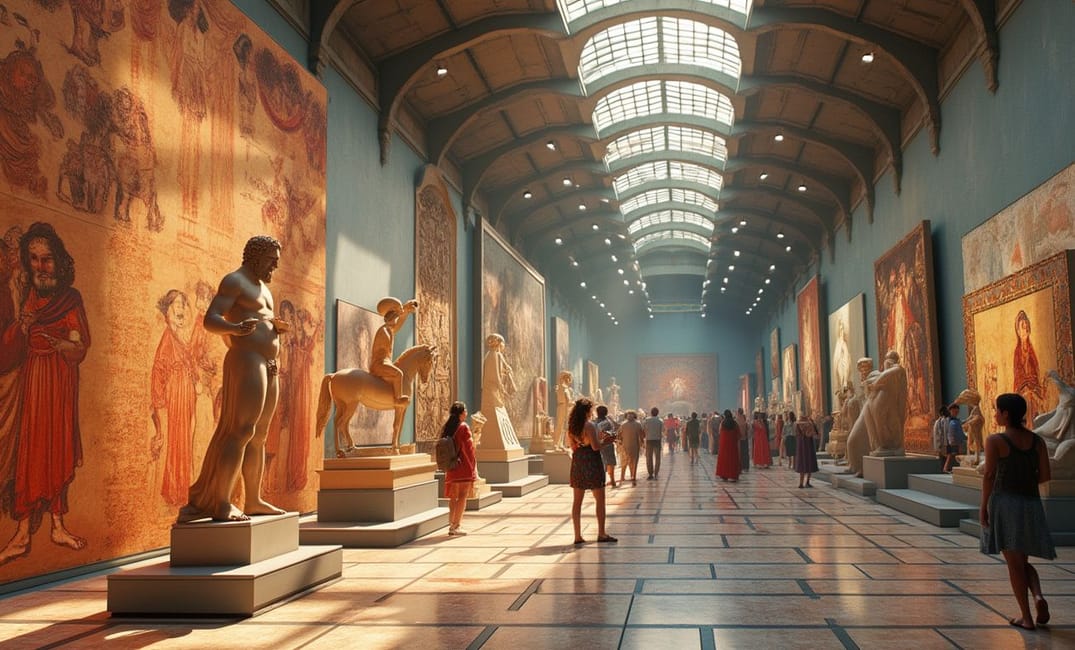Introduction: The Canvas of Human Expression
Visual arts have been a cornerstone of human expression since ancient times, offering a medium through which creativity, emotion, and culture converge. From the earliest cave paintings to contemporary digital installations, art has evolved in tandem with humanity, reflecting shifting perceptions, societal changes, and technological advancements. Art captures imagination, challenges conventions, and fosters dialogues across time and space. This entry delves into the timeline of visual arts, exploring its evolution, impact, and the myriad forms it has taken to become an integral facet of human civilization.
The Dawn of Artistic Expression: Ancient Art and its Significance
Prehistoric Paintings: The Birth of Human Creativity
- Cave Art and Symbolism: The prehistoric era heralded the birth of art, evident in caves across continents like Lascaux and Altamira. These early paintings depicted animals and human figures, signifying communication, ritualistic practices, or metaphysical beliefs. They stand testament to the depth and complexity of early human thought and creativity.
- Rock Carvings and Petroglyphs: Beyond cave paintings, people adorned rocks with petroglyphs and carvings. These tactile expressions potentially chronicled events or educated future generations. The tactile interaction with nature highlighted humanity's intrinsic desire to impose lasting marks upon the world.
The Artistic Flowering of Ancient Civilizations
- Egyptian Hieroglyphs: In ancient Egypt, art served also as a narrative tool through hieroglyphs. These intricate symbols chronicled history, religious beliefs, and societal structures, combining art with language into a unified cultural odyssey.
- Mesopotamian Sculpture and Reliefs: Mesopotamia's art, embodied in sculptures and bas-reliefs, offered profound insights into imperial power and transcendental narratives. Ziggurat reliefs and statues intertwined the divine with the mortal, employing art as divine narrative structure.
Classical Antiquity: The Artistic Seed of Western Thought
- Greek Sculpture and Aesthetics: The Greeks revolutionized art with their focus on humanism and idealism, epitomized in sculptures like the Venus de Milo and Discobolus. They conceptualized art as philosophy, seeking to depict beauty through geometric harmony and proportional balance.
- Roman Art and Propaganda: Romans extended Greek artistic sensibilities, embedding art into public life and politics. Roman sculptures, mosaics, and frescoes manifested imperial authority and civic pride, rendering art a tool of statecraft as much as cultural enrichment.
The Luminous Middle Ages: Spirituality and Symbolism
Byzantine Iconography and Religious Art
- Icons and Mosaics: The Byzantine Empire embraced iconography, with religious figures represented in mosaics and illuminated manuscripts. These art forms were devotional aids, reflecting theological teachings and inviting reflection on the divine.
- Expression Through Illumination: In the Dark Ages, monastic scribes crafted illuminated manuscripts—cultural treasures of intricate detail threaded with religious narratives. They unified textual wisdom with visual splendor, preserving knowledge through artistry.
The Gothic Era: An Architectural and Artistic Merger
- Stained Glass and Cathedrals: Gothic cathedrals were canvases for stained glass art, where kaleidoscopic tableaux washed holy light across stone interiors. These narratives depicted biblical tales and saints, transforming domestic worship into ethereal experience.
- Carved Reliefs and Altarpieces: Sculptures adorned gothic edifices, with elaborate altarpieces depicting sacred scenes. These compositions bespoke devotion and community identity, bridging believers with spiritual ideals through perceptual encounters.
The Renaissance: Rebirth of Classical Ideals and Humanism
The Quest for Perfection: Painting and Perspective
- Leonardo, Michelangelo, and Raphael: The Renaissance reawakened classical ideals, with masters like Leonardo da Vinci, Michelangelo, and Raphael encapsulating the human form with lifelike perspective and emotional depth. Their collective endeavors inspired generations seeking harmony between art and science, emotion and intellect.
- The Advent of Linear Perspective: Artists like Brunelleschi and Masaccio pioneered linear perspective, reconstructing spatial depth within two-dimensional fields and refining depiction forms to reflect the evolving embrace of realistic representation.
The Human Experience: Expanding Art’s Emotional Spectrum
- Portraiture and Self-Representation: Artists like Jan van Eyck and Albrecht Dürer contributed to the flourishing of portraiture, highlighting individuality and introspection. These portraits offered patrons recognition and immortality through artistic gaze.
- Religious Narratives and Mythology: Botticelli and Titian delved into mythological narratives, weaving allegory with artistic beauty. Their work redefined humanity's connection to legends, arts, and gods, navigating a society transitioning into broader comprehension.
The Baroque and Beyond: Drama and Innovation
The Baroque Dynamic: Movement and Emotion
- Caravaggio and Chiaroscuro: Baroque artists, such as Caravaggio, imbued paintings with movement and heightened emotional contrasts through chiaroscuro. This technique manipulated light and shadow to unveil poignant human experiences.
- European Opulence in Sculpture and Architecture: Artists like Bernini elevated sculpture and architecture to dynamic, storytelling marvels. His sculptures, full of theatrical motion, encapsulated an age driven by grandeur and reflection of divinely ordained creativity.
Rococo to Neoclassicism: Aesthetic Shifts
- Rococo’s Elegance and Intimacy: The Rococo period engendered delight in ornamentation and color vibrancy. Artists like Fragonard reveled in allegorical play and sensual perception, capturing lighter narratives amidst society’s shifting contexts.
- Neoclassical Revivals: Neoclassicism returned to austere grandeur, drawing from Greco-Roman ideals. Exemplified by artists like Jacques-Louis David, this movement aligned art with intellectual reflection amidst revolutionary historical backdrops.
The 19th and 20th Centuries: Art’s Evolution in Modernity
Romanticism and Realism: Heartfelt Depictions
- Romantic Interpretations: Passion and human emotion rooted Romanticism, thriving through artists like Delacroix and Turner. Their works championed self-expression, channeling nature's epic spirit and human fragility against tumultuous historical narratives.
- Realism and Society: Artists like Courbet and Millet confronted societal conditions with realism, unflinchingly portraying working-class struggles. Such paintings championed lived experience, challenging audiences to acknowledge stark realities with resonance.
The Avant-garde: Breaking Boundaries
- Impressionism and Light Play: Impressionists like Monet captured fleeting light and movement, diverging from formal academic restraints. Their brushstrokes and perceptual shift exemplified modern explorations of experience, prompting broader artistic liberation.
- Cubism and Perspective Abstractions: Picasso and Braque revolutionized visual perception through Cubism, dissecting and reassembling form. Their abstraction encouraged others to see beyond conventional bounds, embracing multifaceted realities within singular frames.
Postmodern Art and Innovation
- Surrealism and Inner Psyche: Artists like Dalí delved into the subconscious, channeling dreamscapes and psychological themes. Surrealism extended visual vocabulary into existential terrains, articulating humanity's deeper, intricate array.
- Abstract Expressionism and Context: Movements like Abstract Expressionism, marked by artists like Pollock and Rothko, prioritized emotional resonance over subject depiction. Art surrendered its representational vestments, becoming fields for meditative, emotive retrospection.
Contemporary Art: Digital, Diverse, and Interactive
The Digital Revolution and Multimedia Exploration
- Digital Installations and Interactive Art: Artists leverage technology, creating immersive installations through mediums like virtual reality and digital simulations. Interactivity invites participatory spectators, transforming the art experience into collaborative dialog.
- Video Art and New Media: New media artists, like Bill Viola, explore temporal boundaries through video art, probing the intersection between image, sound, and viewer perception. These reflective dialogues challenge sensory interaction, authenticating art in digital spheres.
Art and Society: Reflecting and Reshaping Realities
- Feminism and Social Justice: Contemporary artists address identity, gender equality, and justice through thematic advocacy. Their works humanize narratives, inviting introspection and inspiring change within cultural landscapes.
- Environmental Awareness and Sustainability: Eco-artists champion environmental themes, advocating conservation through their creative platforms. Temporal installations challenge impermanence notions, fostering engagement and vulnerability towards planetary stewardship.
Conclusion: All of Humanity's Artistic Legacies
Visual arts endure as mirrors, reflecting humanity’s evolution, emotions, and aspirations through the ages. Their eclectic expressions transcend cultures, illuminating shared pursuits of beauty, knowledge, and transcendence. Contemporary art, fostered by technological advances, continues this narrative journey, challenging perceptions and stirring meaning in a world marked by rapid change.
From primal etchings to sophisticated digital expressions, art integrates ancient echoes with contemporary visions, carving humanity's enduring legacy onto cosmic canvases.
"Art is the signature of civilizations, painting humanity's quest for connection, echoing across epochs, bound only by imagination."
ART HISTORY, CULTURE, INNOVATION, HUMAN EXPRESSION, MODERN ART, CREATIVITY, ANCIENT ART, VISUAL ARTS

